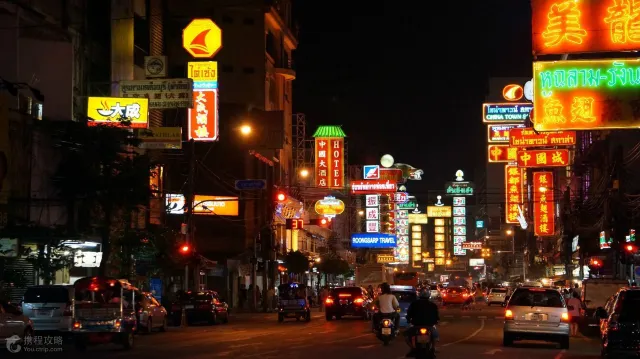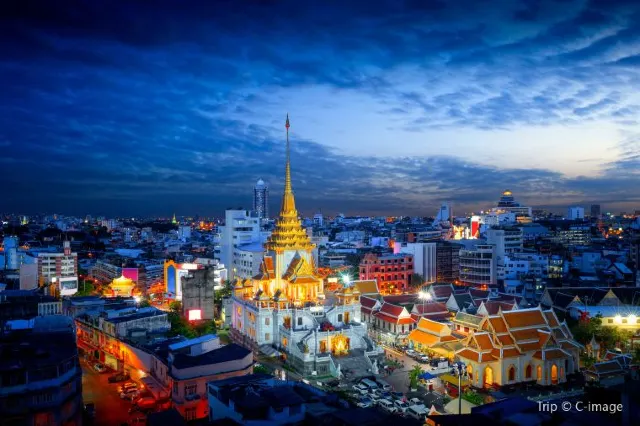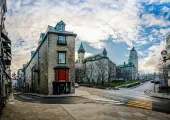A comprehensive guide to Chinatown Bangkok
Catalogue
- History of the Neighborhood
- Visiting Temples
- 1. Wat Traimit
- 2. Wat Mangkol Kamalawat
- 3. Wat Chakrawat Rachawas
- 4. Kuan Yim Shrine
- Eating and Drinking
- 1. Lek & Rut Seafood
- 2. T & K seafood
- 3. Guay Chub Auan Pochana
- 4. Grand China Princess Hotel Rooftop Bar
- 5. Teens of Thailand Bar
- 6. El Chiringuito
- Shopping
- 1. Sampeng Lane
- 2. Old Siam Plaza
- 3. Talat Mai
- 4. Little India
- Getting There
Show More
An absolute favorite among shoppers, Chinatown Bangkok is a 1 km strip that houses some of the most eclectic shops while keeping it real for the tourism shopping. A food haven, Chinatown Bangkok houses a number of new generation market stalls that ooze with the latest glocal delicacies. The endless rows of wooden houses are a sight to behold and are sure to get you packed with a sense of adventure amidst the hustle and bustle as you make your way through the alleyways. The perfect amalgamation of Chinese and Thai traditions, the place holds a fascinating experience that are sure to get you clicking photos all the way through. Stunning temples, exotic food and crazy shopping are what defines Chinatown.

Founded in 1782 when Bangkok was established as the capital of Rattanakosin Kingdom, Chinatown Bangkok became home to the largest immigrant group of Thailand. When King Taksin took reign of the Thonburi Kingdom, he was helped by the Twochew mechants to supply rice and provisions to his capital Thonburi. In return, the Teochow merchants were granted land along the Chao Phraya River. A few more annexations and place shifting later, fast forward to the 19th century and Chinatown Bangkok with is talented merchants became a prominent commercial area, including a red-light district that hosted opium dens and night clubs. Post the 20th century, trade declines and the well-off residents shifted to other places of the city. However, the remaining population continued to practice traditional Chinese culture gradually assimilated into Thai society. The place is the Chinese cultural center in Thailand and the Thai government has recently revived its vibrancy through several construction projects including the Blue Line of the underground MRT. Yaowarat serves as the main artery of Chinatown Bangkok, while other areas in the neighborhood are Odeon circle, Sampheng, Cahroen Chai, Talat Noi and Song Wat.
Chinatown houses several old temples that each have their own uniqueness and uphold the traditional architecture.
Home to world’s largest golden statue of a sitting Buddha, the image is made of a whopping 5 and half tonnes of 18 karat gold. Incidentally this was accidentally six decades ago when it was dropped while being moved, which revealed the golden interior within its plaster case. Tourists flock to this temple in Chinatown Bangkok as it a glistening white beauty tipped with traditional Thai golden arches. A regular among tourists and locals alike, the place is close to the Hua Lampong MRT station. The temple houses a museum on the 3rd floor, where you can learn all about the history of the sculpture. The 2nd floot houses 3D presentations that give you a brief overview of the original inhabitants of Bangkok Chinatown. A view from the top of the temple, also gets you a nice look at the Chinatown Gate. The temple is open daily from 8 am to 5 pm.

The largest and most important Chinese Buddhist temple in Chinatown Bangkok, Wat Mangkol Kamalawat is well known for hosting a number of celebrations on a grand scale including Chinese New Year and the annual Chinese vegetarian festival. Located in Pom Prap Sattru Phai district in Chinatown Bangkok, the temple is accessed by an alleyway on the Charoen Krug Road. A low rambling structure, the temple holds all the iconic sights you’d want to see in a Chinese temple; beautiful and ornate dragons, incense filled courtyards and gilded Buddha images. Also known as the Wat Leng Noei Yi or Dragon Lotus Temple, this temple was established as a Mahayana Buddhist temple around 1871 and is decorated in the architectural style typical of the period. You can easily get to the temple via a ferry across Rtchawong pier. Surrounding the temple are vendors selling lotus-shaped dumplings and oranges, that are meant as offering to the temple deity. If you’re lucky to eb in Bangkok around Chinese Year, you will get to see this temple in all its glory as throngs of pilgrims throng here to take part in the festivities.
Wat Chakrawat prides itself as one of the temples that still houses a large community of monks and novices. With an interesting backstory, the temple is colloquially known as The Crocodile Temple. The story goes that there was a one-eyed crocodile or ‘Ai-Bod’that was famed man-eater who would terrorize villagers on both sides of the Chao Praya River. So the residents along the river bank took it upon themselves to chase the crocodile, who ended up under the house of a monk in the Wat Chakrawat. The monk asked for the crocodile as alms and the people happily obliged, as long as he was kept away from the river banks. You can still find the Ai-Bod today, stuffed and placed on a pier surrounded by his living mates within the temple gates. The Wat Chakrawat is a prime example of 19th century architecture and houses a mondop that is topped with a Khmer-style prang, containing a beautiful Buddha footprint shrine. A visit to Wat Chakrawat suddenly invites you to a calm and peaceful atmosphere amidst bustling Chinatown Bangkok. The easiest way to get to the temple is by taking a boat to Ratchawong Pier and taking a short walk from there.
Despite not being one that features a lot on the Chinatown Bangkok guides, Kuan Yim Shrine is part of the Thien Fah foundation, which was the first foundation that gave deprived patients treatments in the form of both modern and traditional Chinese medicine. One of the temples of Mahayana Buddhism faith, the temple sees thousands of pilgrims seeking prayer and rectitude within its walls. The Kuan Yim shrine is carved in teakwood in typical Thang Dynasty style, almost 800-900 years ago. The colorful architecture combined with the mystical ambience makes this one, a must-visit in Chinatown Bangkok.
If there’s one reason why both the young and old throng towards the streets of Bangkok Chinatown, its the scrumptious street-style food that’s sure to tingle your taste buds. However for the visitor, the number of options might just overwhelm you to the point of too much wasted time in deciding and too little actual eating. Read on to find the best spots in the neighborhood.
The best set-up for a good street-food style family dinner, Lek-Rut Seafood is packed with people patiently waiting for a seat or just standing out on the streets and waiting for their meals. Set on a narrow sidewalk at the heart of Chinatown Bangkok, the place just enthralls you into the real Thai food venture. Big river prawns, grilled on request is the must try here. Cockles, scallops stuffed with pork and bacon and the fried black crab are also a specialty.
Also situated in Yoawarat, the place opens in the evening and entices you with the aroma of grilled shrimp and fish. Known for its killer Or Suan (Oyster Omelets), the sizzling dish comes with a crispy golden edge that’s hard to resist. Not a fine-dining restaurant by far, the place however offers more comfort than Lek & Rut seafood. If you’re a spice lover, T&K Seafood has the best to offer in town.

Guay Chub Auan Pochana is a haven for the rice noodle fans. Located just outside of Chinatown Bangkok’s Rama Theatre, the place is a popular diner among both tourists and locals. Due to the throngs of people coming in, the chef’s work is never ending and is the craftsmanship displayed is a pleasure to watch on its own. Try out the most popular and common Kuay Jub to get you started on a hearty serving of rice noodles and delicate crispy pig parts, pork belly and offal broth that comes in a very inviting bowl. If you aren’t into pig intestines, you can ask for a bowl that only includes the pork belly. Take a few orders to go and enjoy the meal once again at the comfort of your room, or it would suffice to say that you’ll be leaving the place painfully wanting to return there when the rains start!
Situated in the Grand China Trade Tower right in the middle of Chinatown Bangkok’s business district, the Grand China Princess Hotel is a fully functional hotel with modern amenities housing 155 guestrooms. Not just for stay, the hotel’s rooftop bar is a fine choice for a romantic wine & dine. Located on the 25th floor, the place is the only revolving bar in Bangkok. The place offer a scenic view of the city skyline, complete with a view of the Chao Phraya River. With live music every evening, the place is the perfect getaway from the hustle and bustle right underneath it while you enjoy some light snacks and a refreshing drink.
Located on the fringes of Chinatown Bangkok, the Teens of Thailand Bar has made it’s way into many of the top 50 lists from around the world. Hidden behind an ominous looking wooden door, the bar features a stripped back interior, with bare cement walls that are only lightened up by the works of Kachain. One for the gin-enthusiast, Teens of Thailand is quite popular for its ever-changing cocktail menu. Of course, Singha is always available.
A mere 5 minute walk away from the Hua Lamphong MRT Subway Station, El Chiringuito is one that’s a favorite among Bangkok’s European expat community. A chic bar with a tapas twist, the place has an inviting atmosphere with it’s exposed brick walls and vintage décor. The place is serves some of the best bocadillos, croquettes and chorizo pizza in true Spanish style. While the menu isn’t elaborate, reckon it doesn’t need to be as the place exudes a homely confidence and pair well with a mug of beer. El Chiringuito is sure to make you feel home-away-from-home.
The epitome of Chinatown Bangkok shopping, Sampeng Lane is often overly congested with fabrics, cheap clothes and electronics vendors. The hectic nature of the narrow streets may take you aback, but fret-not; it’s all part of the fun. The place is a discount hub and of course bargaining is very much on the cards.
A remnant of old-world shopping, this shopping mall in Chinatown Bangkok takes you back to the charm of a retro mall that’s the perfect amalgamation of good shopping and good food. Get a load of retail therapy and purchase anything from handicrafts to appliances here. This hidden gem is a three story building that most of the youngsters give a miss, but is the place you need to be if you want to see old-meets-new IRL. While you’re there pick up some sweet treats like woon grob and kanom buang.
The quintessential Chinese market, the place is a souk for dried specialties, seasonings spices and sauces that ooze the goodness of authentic Thai-Chinese cuisine. While you may think that shopping for spices isn’t the ideal way to spend a day on vacay, if you’re into incense and fragrances along with Feng Shui items, the place gives you plenty of options that are sure to spruce up your home with positivity and calm.
Phahurat Market or Little India Bangkok is situated very close to the Chao Phraya River near Chinatown Bangkok. Just a small road, the place is home to Bangkok’s largest Indian community and even houses a Sikh temple. The golden-domes Sikh temple is the second largest outside India. If you are a vegetarian, don’t miss out on the free breakfast served at the temple. Unsurprisingly, textile and fabric are the popular items here. However you can also find some jewelry, spices and artworks. But the highlight of course is the food here. Several restaurants around here serve up some scrumptious roti/naan and curry.
The best way to get to Chinatown is by taking a boat to Ratchawong Pier. Take the Chao Praya River Express Boat and once you reach the pier, the gate is just a short walk away. There also local buses available, but the traffic might drain your energy before you even get there. If you want to reach quickly though, you can take the subway and get off at the Wat Mangkon Subway station. Taxis and tuk-tuks are also another option, but you need to ensure that the driver uses the meter so that you don’t get overcharged. Once you’re there, a fun little way to get around the area is to rent a bike. It is recommended that you carry a map and keep a translation app handy. For shopping, make sure you carry hard cash so that you avoid transaction charges.
Trending Travelogues
Popular Trip Moments
Popular Travel Types
Popular Attractions
Popular Ranked Lists
Popular Destinations
Recommended Attractions at Popular Destinations
About











Site Operator: Trip.com Travel Singapore Pte. Ltd.







